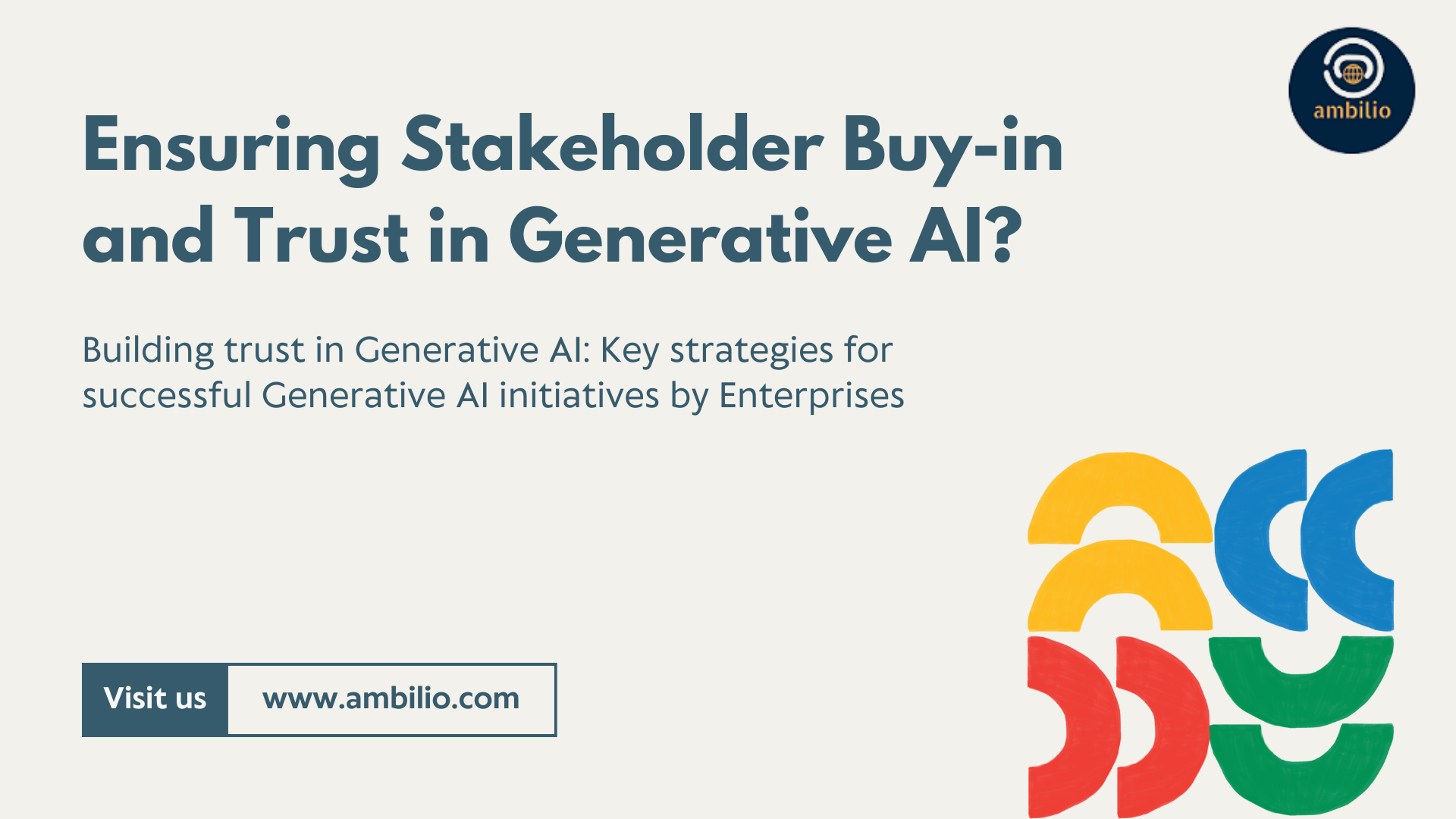As generative AI technologies like large language models and text-to-image systems rapidly advance, organizations are eager to leverage these powerful tools. However, successfully implementing generative AI initiatives requires more than just technical expertise – it demands careful attention to building stakeholder buy-in and trust. Without proper engagement and transparency, AI projects risk faltering due to resistance, misunderstandings, or ethical concerns. This article explores key strategies for cultivating stakeholder support and confidence in generative AI initiatives.
How to Ensure Stakeholder Buy-in and Trust in Generative AI Initiatives
Here are the curated strategies for ensuring stakeholder buy-in and trust in Generative AI initiatives by enterprises.
Educate and Demystify
A crucial first step is educating stakeholders on the fundamentals of generative AI. Many may have misconceptions or outsized expectations based on headlines or science fiction. Provide clear, accessible explanations of how the technology actually works, its current capabilities and limitations. Demystify the “black box” nature of AI systems by breaking down the training process, data sources, and key architectural elements.
Host workshops, provide documentation, and encourage questions to build a shared understanding. Address common concerns head-on, such as AI bias or job displacement fears. The goal is to foster AI literacy so stakeholders can engage in informed discussions and decision-making.
Align with Organizational Values and Goals
Carefully articulate how generative AI initiatives support broader organizational objectives and values. Map out specific use cases and expected benefits, whether improved efficiency, enhanced creativity, or new product/service opportunities. Demonstrate how AI aligns with the company’s mission and ethical principles.
Work with leadership to develop a clear AI strategy and roadmap integrated with overall business plans. This helps stakeholders see generative AI not as a shiny new toy, but as a strategic tool for achieving shared goals.
Engage Early and Often
Involve key stakeholders from the earliest stages of AI planning and throughout implementation. Create cross-functional teams and steering committees to ensure diverse perspectives are considered. Conduct listening sessions to understand hopes, fears, and ideas from various stakeholder groups.
Maintain open channels of communication as initiatives progress. Provide regular updates, demos, and opportunities for feedback. Be responsive to concerns raised and show how input is incorporated. Early and continuous engagement helps stakeholders feel ownership over the process rather than having AI thrust upon them.
Prioritize Ethics and Responsible AI
Demonstrating a strong commitment to ethical AI development and deployment is crucial for building trust. Develop clear ethical guidelines and governance frameworks for generative AI initiatives. Address key issues like data privacy, bias mitigation, transparency, and human oversight.
Consider creating an AI ethics board with both internal and external experts. Conduct thorough impact assessments for high-stakes AI applications. Implement ongoing monitoring and auditing processes to ensure responsible use. By prioritizing ethics from the start, organizations signal that they take potential risks seriously.
Start Small and Iterate
Rather than attempting a massive AI overhaul, begin with smaller pilot projects to build confidence and prove value. Choose initial use cases carefully – look for clear ROI potential and minimal disruption to existing workflows. Set realistic goals and timelines.
As pilots succeed, gradually expand scope and complexity of AI applications. Celebrate and publicize early wins to build momentum. Use lessons learned to refine processes and address stakeholder concerns before scaling up.
Upskill and Empower Employees
Stakeholder trust in AI initiatives increases when employees feel empowered rather than threatened. Invest in comprehensive training programs to build AI literacy and hands-on skills across the organization. Create opportunities for employees to experiment with generative AI tools in low-stakes environments.
Emphasize how AI can augment human capabilities rather than replace jobs. Showcase examples of employees successfully leveraging AI to enhance their work. Encourage innovation and reward creative AI applications from staff.
Ensure Human-AI Collaboration
Design AI systems and processes that keep humans in the loop. Clearly delineate what decisions and tasks will be performed by AI versus humans. Implement strong human oversight, especially for consequential or sensitive applications.
Emphasize AI as a collaborative tool that enhances human judgment and creativity rather than an autonomous replacement. This helps allay fears of AI taking over and builds trust in the technology as a productivity aid.
Maintain Transparency
Be open about both the successes and challenges of generative AI initiatives. Share performance metrics, but also acknowledge limitations and areas for improvement. If issues like biased outputs arise, address them promptly and transparently.
Provide clear information on how AI systems are developed, trained, and monitored. Offer appropriate levels of explainability for AI-driven decisions or recommendations. Transparency builds credibility and allows stakeholders to provide informed input.
Measure and Communicate Impact
Develop clear KPIs to measure the impact of generative AI initiatives, both quantitative and qualitative. Regularly report on progress against these metrics. Go beyond just efficiency gains to capture broader effects on innovation, employee satisfaction, customer experience, etc.
Share concrete examples and success stories that bring the benefits of AI to life for various stakeholders. Data-driven results paired with compelling narratives help reinforce the value of generative AI investments.
Final Words
By employing these strategies, organizations can cultivate the stakeholder buy-in and trust necessary for successful generative AI initiatives. Building confidence in AI is an ongoing process that requires sustained effort and open dialogue. With proper engagement and responsible development practices, the transformative potential of generative AI can be realized while addressing valid concerns and staying true to organizational values.



